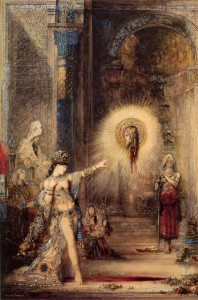 The woman depicted in The Apparation by Gustave Moreau seems to be a femme fatale. The painting’s focus on the woman, her exotic outfit and her bare skin creates an erotic impression, and the murder of John the Baptist suggests that her sexuality is what makes her dangerous. The depictions of the woman’s sexuality also reminds me of the woman in The Lady of Shalott by Alfred Tennyson, and how she was punished by death for acting upon her sexual feelings. Therefore, the women in The Apparation and The Lady of Shalott are depicted as dangerous because of their sexuality, which suggests that the 19th century attitudes towards women’s sexuality were that it should be suppressed, and the ideal woman was pious and a virgin.
The woman depicted in The Apparation by Gustave Moreau seems to be a femme fatale. The painting’s focus on the woman, her exotic outfit and her bare skin creates an erotic impression, and the murder of John the Baptist suggests that her sexuality is what makes her dangerous. The depictions of the woman’s sexuality also reminds me of the woman in The Lady of Shalott by Alfred Tennyson, and how she was punished by death for acting upon her sexual feelings. Therefore, the women in The Apparation and The Lady of Shalott are depicted as dangerous because of their sexuality, which suggests that the 19th century attitudes towards women’s sexuality were that it should be suppressed, and the ideal woman was pious and a virgin.
As the woman is in the foreground in The Apparation, the observer’s focus is drawn to her. The woman’s body seems to be “put together:” She has a long, bare leg, an upper body which accentuates her breasts, and a long, sensuous neck. The portrayal of the woman therefore reminds me of “the male gaze,” as sensual parts of her body are put in focus. However, as the jewelry that drapes her body suggests that she has monetary value, her sexuality has associations to a prostitute. In the background, a man sits on a throne, which could be her father. Since he is in the background and depicted as passive, and the woman appears to not have a husband, the patriarchy seems to be defied. Therefore, the painting suggests that sexually active women are a threat to the patriarchy. Furthermore, since it seems that the woman ordered the murder of John the Baptist, sexually active women were also a threat to religion – or more specifically Christianity – and shows the ideal of pious women, who are virgins until marriage. The walls of the room have ornamental decorations, and the clothing of the people in the room give me associations to East-Asian countries. Therefore, the painting seems to stereotype women of the East, and suggests that they, and their active sexuality, are a danger to the West, Christianity and patriarchy.
The femme fatale in The Apparition reminds me of the woman in The Lady of Shalott. Though she is not depicted exactly the same way as the woman in the painting, the poem shows the same ideal that women should suppress their sexuality: “A curse is on her if she stay / To look down to Camelot” (135). As Camelot is where men are, the “curse” suggests that she cannot act upon her sexual feelings. However, as she did look and died as a result from it, she was punished for longing for a man, which shows the ideal that women should “wait” while men “seek.” Therefore, while the woman in the painting is a femme fatale and dangerous because she is sexual, the woman in the poem was “turning into” a femme fatale by acting on her sexuality, and was punished for it by death.